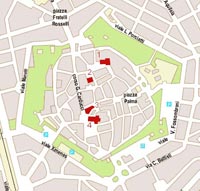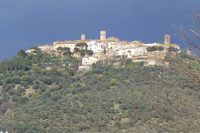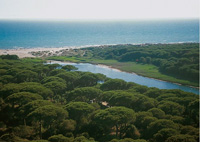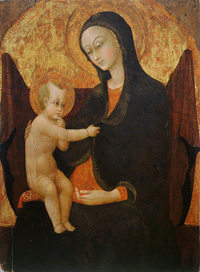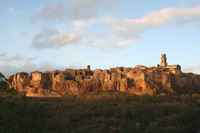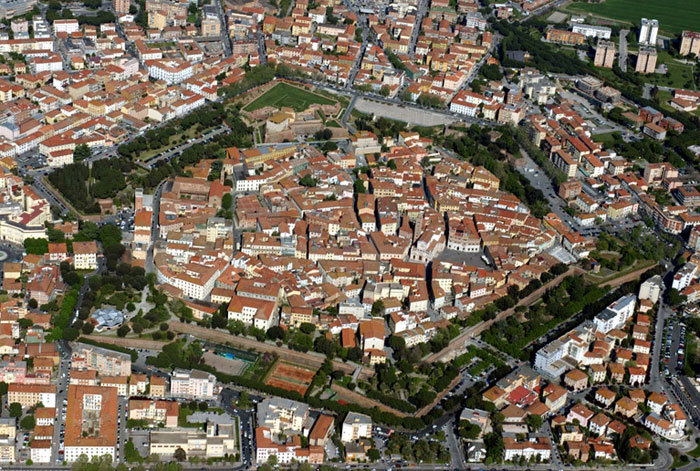 |
|
Grosseto |
|
|
Grosseto |
Grosseto is a town and comune in Tuscany, and the capital of the Province of Grosseto. Grosseto lies on the Tuscan coast of the area known as the Maremma, a large and diverse area covering parts of southwestern Tuscany and some of northern Latium. The Alta Maremma is the northern part, from Grosseto northwards to Cecina River just south of Livorno. Market in Grosseto is on Thursday.
|
|
|||||
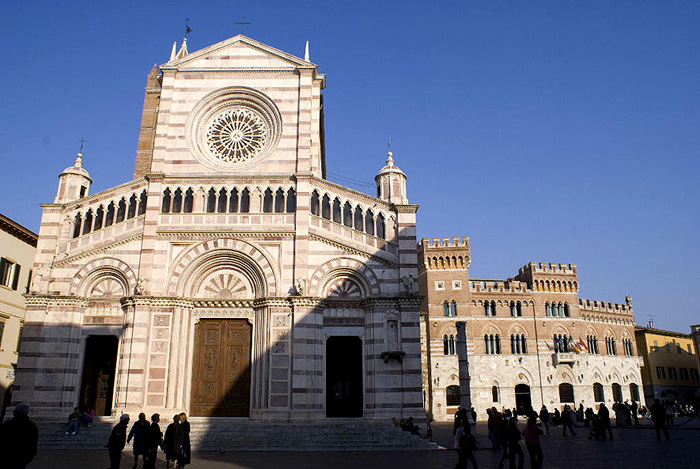 |
||||||
Grosseto, Piazza Dante and Duomo San Lorenzo |
||||||
Duomo San Lorenzo Palazzo Aldobrandeschi
|
||||||
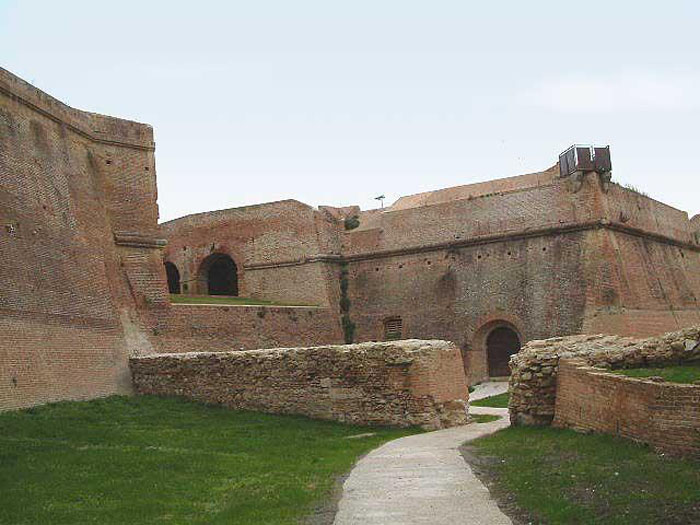 |
||||||
Grosseto, the Medicean Walls |
||||||
| The imposing and well-preserved Medicean walls date back to the 16th century, when Grosseto was the southernmost outpost of the Grand Duchy of Tuscany against Stato dei Reali Presidi Spagnoli. With a perimeter of 2900 metres, they still surround the city’s old town today. |
||||||
Museo Archeologico e d’Arte della Maremma - Museo di Arte Sacra della Diocesi di Grosseto |
||||||
| The archeological and art museum and the Museo di Arte Sacra della Diocesi di Grosseto are housed in the former courthouse, the Palazzo del Vecchio Tribunale. The Museo Archeologico e d’Arte della Maremma has a collection of 5000 prehistoric, Etruscan and Roman relics. It is organized into 5 sections and presents the vicissitudes of the Etruscan city of Roselle in chronological order. One section is dedicated to the archeology of the province of Grosseto, excluding Roselle, from prehistory to late antiquity. Founded in 1933, the Museum of Sacred Art of the Diocese of Grosseto also occupies the Palazzo del Vecchio Tribunale in the centre of Grosseto. Of great value is the collection of works mostly coming from the Cathedral of Grosseto, but also from many churches in the Diocese, attributable to Siena artists working in the area. The 13th century Giudizio Finale originally in the Chiesa di San Leonardo in Grosseto is attributed to Guidoda Siena or his school, the Cristo in Pietà by Pietro di Domenico (late 15th century), the Madonna by Girolamo di Benvenuto (early 16th century), the Madonna delle Ciliege by Sassetta (mid 15th century) coming from the Duomo di San Lorenzo as well as fragments of masonry from the exterior of the Duomo (Agostino di Giovanni, 14th century) and marble angels. Museo Archeologico e d’Arte della Maremma, Museo di Arte Sacra della Diocesi di Grosseto, Palazzo del Vecchio Tribunale, Piazza Baccarini, 3, tel.0564/455132 Convent of St. Francis In the nearby Piazza San Francesco the church bearing the same name dates from the 14th century. The interior has a 13th century crucifix and a frescoe depicting San Cristofano. It is an unparalleled complex of great historic and artistic value, composed of convent rooms, the sacristy and the church. The church, consecrated in 1289, is severe and unadorned as the rules of the Franciscan order ordained. It has a facade decorated with a simple rosette and a fresco above the entry. The interior, which has a single nave, contains a very valuable work of art: the Cross on a tablet attributed to Duccio di Buoninsegna (1255/60 - 1319), the great Sienese artist who began the process of progressively humanising sacred figures, putting an end to the seriousness of the Byzantine tradition. The Christ depicted is animated by chiaroscuro effects and an extreme delicacy in his facial features. In addition to the numerous 14th and 15th century frescoes that decorate the church walls, it is possible to admire a cycle of Baroque painting by the Amiata painters Antonio and Francesco Nasini. These are located in the 18th century chapel dedicated to St. Anthony of Padua. The fresco of Transito di sant’Antonio stands out for its elegance of execution. The cloister, around which the rest of the structure is built, was restored by Ferdinando I de’ Medici in 1590. He had a well, called the Bufala, built to compensate the monks for the loss of a wing of the convent, destroyed to make space for the imposing Medicean Walls. The bell tower is interesting, although of debatable aesthetic value. Damaged by a lightening-bolt, it was rebuilt at the beginning of the 1900s by Lorenzo Porciatti, who, in accordance with the fashion of the time which called for the recovery of medieval styles, rebuilt it in the Neogothic style.
Siti di interesse storico culturale del Comune di Grosseto |
|
|||||
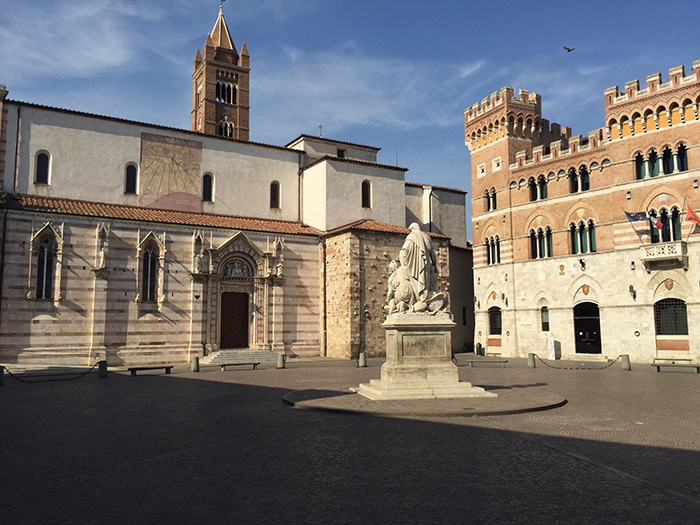 |
||||||
Grosseto, Piazza Dante with the Canapone monument, a sculpture dedicated to the Grand Duke Leopold II of Lorraine |
||||||
|
|
||||||
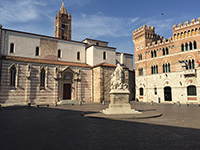 |
 |
|||||
| Grosseto, , Piazza Dante | Chiesa di San Francesco, il fianco della chiesa con il campanile
|
|
Grosseto,, Piazza Dante, Duomo | |||
Photo gallery Bastione Fortezza
|
||||||
 |
 |
 |
||||
Bastione Fortezza con il Cassero Senese
|
Bastione della Vittoria | Il bastione di Santa Lucia e il Cassero Senese visti da sud | ||||
The province of Grosseto offers a fascinating landscape with a great variety, unspoilt beaches with pine forest, high mountains and many places of interest, historic sites, medieval villages and towns and Etruscan excavations. Outside the city there are many nature reserves such as the Parco Naturale della Maremma, the Diaccia Botrona Nature Reserve, the Cetacean Sanctuary, and the National park of the Tuscan Archipelago, of which the Islands known as the Formiche di Grosseto are a part. Places of interest in the surroundings of Grosseto are Castiglione della Pescaia, Montepescali on the way to Gavorrano, Roselle and in the south the Natural Park of the Maremma, one of the main natural reserves of the maremma territory. The Maremma is bathed by a transparent sea along its long and multicolored coastline of sunny beaches and rocky cliffs. The large and accessible sandy shore of the Gulf of Follonica includes coves such as Cala Martina and Cala Violina as well as the furnished beaches of Castiglione della Pescaia, Marina di Grosseto and Principina a Mare. |
||||||
| The main attraction nearby is Castiglione della Pescaia, also known as Terrazzo o Balcone della Maremma, a very attractive town consisting of a fishing boat harbour dominated by a mediaeval castle. The walled Medieval town, complete with towers, gates and a 15th castle, is perched on an outcropping of Monte Petriccio. Originally, to the east of the town, was the antique Lake Prile, an Etruscan possession before it became the Roman Portus Traianus. With the passage of time, the lake began to dry up and was replaced by a vast marsh land which was reclaimed as part of the work promoted by the Grand duke Leopold. The nature reserve of the Diaccia Botrona is what remains of that area today. It is considered one of the most significant wet lands in Italy with a rare ecosystem of international importance. There are some other fascinating spots around Castiglione della Pescaia. Vetulonia is one of the most important Etruscan cities where it is possible to visit the necropolis and the archeological museum. The town of Tirli makes it easy to see what life was like in the Maremma of old. The ancient town of Buriano offers a Medieval castle and a spectacular view over the Maremma. And finally, about 15 km from Castiglione della Pescaia is Punta Ala. Other sight of interest are the ruins of the Abbey of San Pancrazio al Fango, between Grosseto and Castiglione della Pescaia, and the Abbey of San Rabano, also in ruins, located in the Parco Nazionale della Maremma. |
||||||
| Roselle |
||||||
| The archaeological area of Roselle is located about 8 kilometres north of the city of Grosseto. Inhabited since the 7th century B.C. and definitively abandoned only in the 17th century, Roselle is one of the largest visitable archaeological areas in Tuscany. Roselle, now a municipal frazione of Grosseto, was once the main city in the area. In the 6th century B.C. Roselle was a large urban centre: in this period the town was also provided with walls. Their polygonal structure built with sandstone bricks can still be admired today. A very well preserved monumental complex dates back to the Roman Imperial age. It includes: the Forum and its annexes, the Domus dei Mosaici with its sophisticated thermal baths, the amphitheatre, the Spas and the roads paved with flagstones, which show visible marks left by cart wheels. Today’s visitor can take the footpath along the walls, which are especially visible on the northern side, where some of the structures have preserved up to five metres of their original height. The following centres are open to visits: the late-Roman baths, Decumanus, part of the wall belt, Valle del Foro, the hill where the amphitheatre rises, Terme Adriane and the southern hill. Parco degli Etruschi - The archaeological area of Roselle Opening hours: Nov - Feb: 9.00 - 17.30 | Mar - Oct: 9.00 - 19.30 Scientific Itineraries in Tuscany |
 Roselle, footpath along the walls |
|||||
| Montepescali |
||||||
| Montepescali, a town that dates back to the Xth Century, lies in the heart of the Maremma, a few kilometres from Grosseto, near the Poggio Pelliccia. Also called the falcon of the Maremma, Montepescali sits atop a hill, 222 meters above the Aurelia, one of the ancient Roman highways. A large part of the ancient walls, with staggered towers, has been preserved; two gateways mark the boundaries of the entrances to the town: Porta Vecchia, facing the flatland and the sea, is located alongside a lovely circular tower, Torre del Belvedere. From the Baluardo on the western wall of the town, the Tyrrhenian Sea, the island of Giglio, and the highest mountains of Corsica can be seen. Main sights are Torre del Belvedere, Torre del Guascone, Porta Vecchia e Nuova, Baluardo a tre punte, Palazzo Grottanelli, Palazzo Guadagni, Palazzo Guicciardini Corsi Salviati, Palazzo Tolomei, Palazzo Lazzeretti Concialini. The Chiesa di San Niccolò lies in the highest part of Montepescali, near the fortress. Dating back to the 11th century, it is a Romanic style building with a rectangular layout and a gable roof. The walls of the interior are decorated with a cycle of recently restored 14th century frescoes of the Siena school. The well-known altarpiece by Matteo di Giovanni, depicting La Madonna in trono con Bambino e i santi Guglielmo da Malavalle, Sebastiano, Maria Maddalena e Lucia (The Madonna on the Throne with Child and Saints William of Malavalle, Sebastian, Mary Magdalene and Lucy), originally comes from the Chiesa dei Santi Stefano e Lorenzo. The Chiesa dei Santi Stefano e Lorenzo, dating back to the 12th century, is located at the entrance to the town of Montepescali. The church has an interesting 15th century fresco on the left wall L’assunzione della Vergine tra angeli musicanti e santi (The Ascension of the Virgin Among Musician Angels and Saints), Montepescali | History, stories, legends |  Montepescali, Chiesa di San Niccolò |
|||||
Photo gallery Montepescali
|
||||||
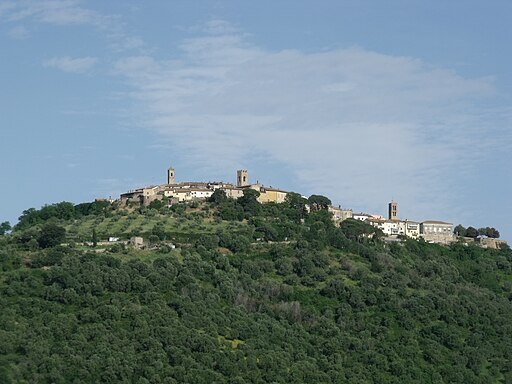 |
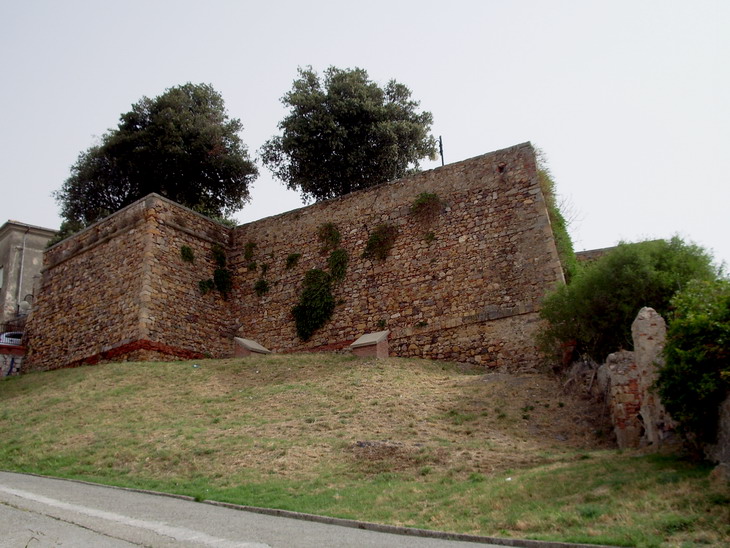 |
 |
||||
| Montepescali, panorama | Baluardo a tre punte Montepescali
|
Cassero Montepescali
|
||||
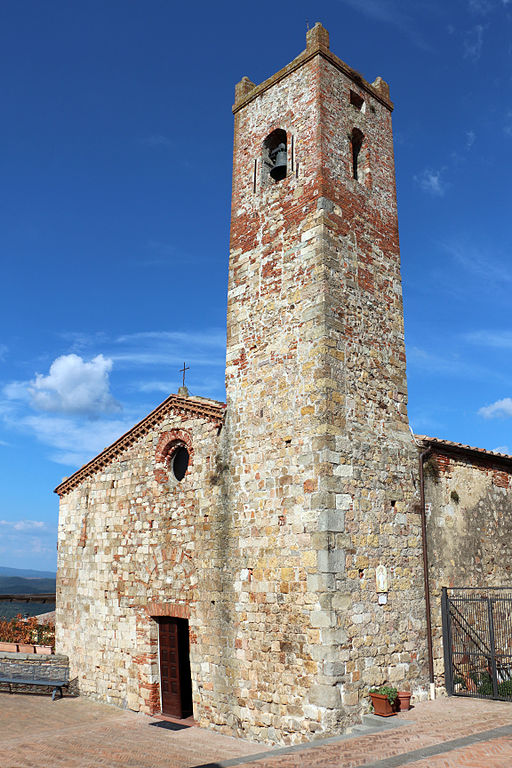 |
 |
 |
||||
| Chiesa di San Niccolò Montepescali | La Torre del Guascone | Torre del Cassero Montepescali | ||||
| The interior of the Maremma |
||||||
| Those who leave the coast and venture into the interior will immediately note the signs of the reclamation of what were formerly marshy areas, then the traces of the age-old exploitation of the agricultural land, woods and minerals. The roads and canals of the reclaimed lands in the plain form geometric patterns, while characteristic features are the rows of eucalyptus planted as wind-breaks and the windmills serving to pump away the water. Straight, deserted roads run between cornfields dotted with the poppies and field flowers that have become a rarity with the spread of modern farming methods; one of the specialities of this area is the Moretti artichoke. Further inland, the landscape of the hills is the result of the system of agriculture known as mezzadria (sharecropping): vineyards and olive groves are interspersed with extensive woods and the thick Mediterranean macchia consisting of holm oaks, strawberry trees, cork-oaks and a dense undergrowth where the wild boar and porcupine find refuge. The more distant they are from the sea, the more the hills become rugged and wooded; here chestnut trees and Turkey oaks form the sparser woods that are ideal for mush roomers in the autumn. To the north, in the southern offshoots of the Colline Metallifere behind Massa Marittima, the wooded landscape stretches as far as the eye can see, inter rupted by the conspicuous erosional phenomena of the clay soils and by limestone out crops. Near Boccheggiano, on the banks of the Merse there's the remarkable spectacle of the old slag-heaps of the nearby pyrites mine at Campiano modelled by wind and water into an ochre and purple moonscape. Those going up the valley of the Ombrone, on the other hand, will notice that the land scape is dominated by the huge cone of Monte Amiata and by Monte Labbro, on which, first of all, there is a prevalence of oak-woods (Turkey and downy oaks), then chestnut trees and, higher up, beechwoods. |
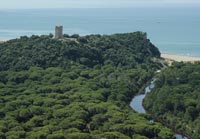 Parco Naturale della Maremma |
|||||
| The scenery of the southern Maremma is very different: this is the realm of tuff, where the plateaux are deeply eroded. Medieval villages and ancient towns perched on top of rocky spurs dominate a landscape that's partially wild, with macchia and undergrowth, and par tially cultivated, with, on the terraces, vines being grown to produce a renowned white wine. This part of Tuscany has preserved important Roman and Etruscan remains, especially at Saturnia, and has a trio of fascinating towns in the eastern part - Sovana, Pitigliano and Sorano - that emerge from the tuff in which they seem to have been sculpted.[1] |
||||||
Porto della Maremma
|
||||
The pleasure harbour, which has held Blue Flag status since 2006, is in Marina di Grosseto and is the perfect base for navigating the coast lapped by one of Italy’s cleanest seas. From Porto della Maremma it is possible to reach the islands of the Tuscan Archipelago National Park, Europe’s largest marine park, every one of which differs in terms of the richness and uniqueness of flora and fauna: Elba, Giglio, Giannutri, Capraia, Montecristo, Pianosa and Gorgona, as well as small islands, such as Formiche di Grosseto, situated between the Tuscan mainland and Corsica.
|
||||
 |
 |
 |
||
Il pescatore. Marina di Grosseto
|
Il Porto di Marina di Grosseto | L'ingresso del porto | ||
|
||||
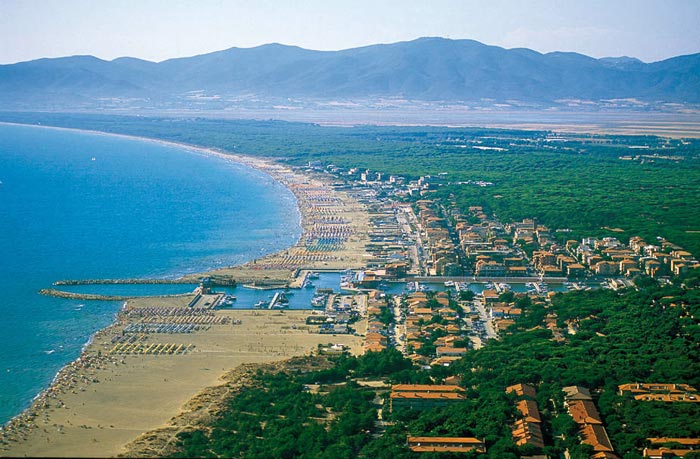 |
||||
Marina di Grosseto |
||||
Surroundings of Grosseto | Alberese 15 km | Cala Violina 38 km | Castiglione della pescaia 22 km | Marina di Grosseto 13 km | Montepescali 16 km | Vetulonia 22 km |
Enlarge map |
|
1 La chiesa di San Francesco | 2 Museo Archeologico e d'Arte | 3 Palazzo del Comune | 4 Duomo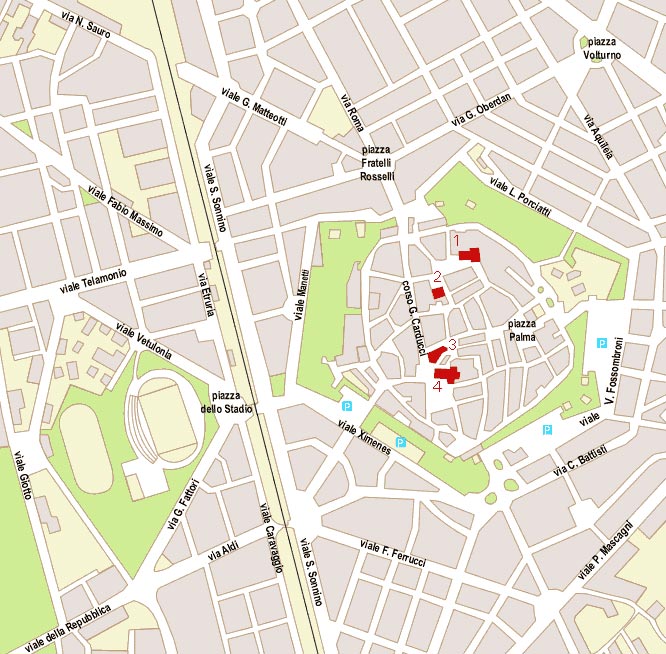 |
Aeroporto della Maremma Corrado Baccarini di Grosseto
|
Holiday homes in the Tuscan Maremma | Holiday home Podere Santa Pia
|
The towns and suburbs of Grosseto Province 58010 Alberese | 58010 Albinia | 58031 Arcidosso | Town Hall address: Piazza Indipendenza 30 58050 Arcille di Campagnatico | 58050 Baccinello | 58021 Bagno di Gavorrano | 58031 Bagnoli | 58030 Bagnolo | 58032 Bagnore | 58041 Batignano | 58020 Bivio di Ravi | 58020 Boccheggiano | 58010 Borgo Carige | 58040 Buriano | 58020 Caldana | 58042 Campagnatico | Town Hall address: Piazza G. Garibaldi 2 58010 Campese | 58050 Cana | 58011 Capalbio | Town Hall address: Via G. Puccini 32 58010 Capalbio Stazione | 58024 Capanne Vecchie 58040 Casale di Pari 58010 Casone 58033 Castel del Piano | Town Hall address: Via Marconi 9 58027 Castel di Pietra 58034 Castell'azzara | Town Hall address: Via G. Marconi 2 58010 Castell'ottieri 58040 Castiglioncello Bandini 58043 Castiglione Della Pescaia | Town Hall address: Via V. Veneto 5 58050 Catabbio 58050 Cellena 58010 Chiarone 58044 Cinigiano | Town Hall address: Piazzale Capitano Bruchi 3 58045 Civitella Marittima 58045 Civitella Paganico | Town Hall address: Via Primo Maggio 6 58010 Elmo 58022 Follonica | Town Hall address: Largo Cavallotti 1 58010 Fonteblanda 58020 Frassine 58023 Gavorrano | Town Hall address: Piazza Bruno Buozzi 16 58020 Gerfalco | 58020 Ghirlanda 58018 Giannutri 58012 Giglio Isola | Town Hall address: Via Vittorio Emanuele 2, 58013 Giglio Porto 58020 Giuncarico 58020 Grilli 58100 Grosseto | Town Hall address: Piazza Duomo 1 58040 Istia D'Ombrone 58020 Lago Boracifera 58051 Magliano in Toscana | Town Hall address: Via XXIV Maggio 9, 58014 Manciano 58046 Marina di Grosseto 58037 Marroneto 58010 Marsiliana 58024 Massa Marittima | Town Hall address: Piazza Garibaldi 8 58030 Monte Antico 58030 Monte Antico Scalo 58019 Monte Argentario | Town Hall address: Piazza Rioni 8 58024 Montebamboli 58010 Montebuono 58030 Montegiovi 58030 Montelaterone 58020 Montemassi 58050 Montemerano 58040 Montenero 58030 Montepescali 58035 Montepescali Stazione 58025 Monterotondo Marittimo | Town Hall address: Via Bardelloni 64 58010 Montevitozzo 58052 Montiano 58047 Monticello Dell'Amiata 58026 Montieri | Town Hall address: Piazza Gramsci 4 58050 Montorgiali 58010 Montorio 58040 Montorsaio 58050 Murci 58020 Niccioleta 58015 Orbetello | Town Hall address: Via Don Carlo Steeb 1 58016 Orbetello Stazione 58048 Paganico | Town Hall address: Via Primo Maggio 6 58050 Pancole 58040 Pari 58050 Pereta 58050 Petricci 58017 Pitigliano | Town Hall address: Piazza Garibaldi 37, 58050 Poderi di Montemerano 58050 Poggio Capanne 58050 Poggio Ferro 58050 Poggio Murella 58050 Polveraia 58010 Polverosa 58050 Pomonte 58018 Porto Ercole 58019 Porto Santo Stefano 58020 Potassa 58020 Prata 58022 Prato Ranieri 58010 Pratolungo 58050 Preselle Sergardi 58040 Punta Ala 58020 Puntone 58020 Ravi 58027 Ribolla 58010 Rispescia 58043 Riva del Sole 58053 Roccalbegna | Town Hall address: Piazza Marconi 1 58036 Roccastrada | Town Hall address: Corso Roma 8 58028 Roccatederighi 58040 Roselle Terme 58031 Salaiola 58010 San Giovanni Delle Contee 58050 San Martino sul Fiora 58010 San Quirico 58010 San Valentino 58050 Santa Caterina 58037 Santa Fiora | Town Hall address: Piazza Garibaldi 58010 Santa Liberata 58040 Sasso D'Ombrone 58029 Sassofortino 58050 Saturnia 58054 Scansano | Town Hall address: Via XX Settembre 34 58020 Scarlino | Town Hall address: Via Martiri D`Istia 1 58020 Scarlino Stazione 58038 Seggiano | Town Hall address: Via Trento E Trieste 19 58030 Selva 58030 Selvena 58055 Semproniano | Town Hall address: Via Roma 35/39 58010 Sorano | Town Hall address: Piazza del Municipio 15 58010 Sovana 58030 Sticciano 58030 Sticciano Stazione 58040 Stribugliano 58010 Talamone 58040 Tatti 58040 Tirli 58030 Torniella 58020 Travale 58050 Triana 58050 Vallerona 58020 Valpiana 58040 Vetulonia 58031 Zancona |
|
[1] The theme of the Tuscan coast has now become a publishing project, realized by the Touring Club Italiano and promoted by the provinces, their chief communes and the tourist organizations of the areas involved, with the aim of bringing the outstanding features and most fascinating tours to the attention of the public at large. One of the most interesting aspects of this project is this general guide to the Tuscan coast and its highlights, with the enclosed road map and outline guide. Together they are a brief but complete source of information for visitors to the area. [Source : Toscanamare Progetto Costa di Toscana | www.touringclub.it] |

